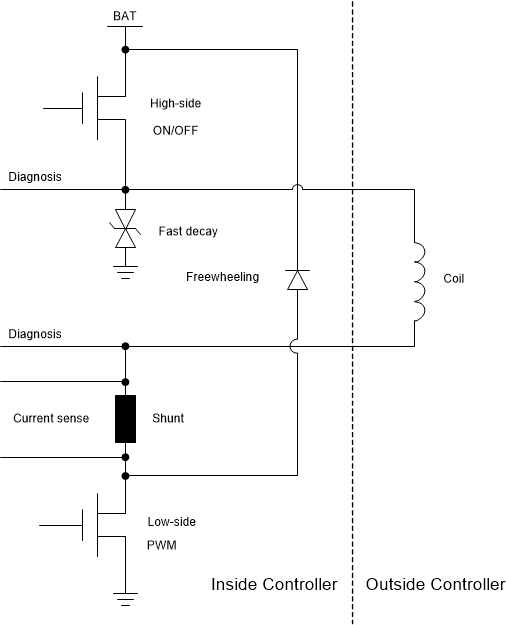SLVAF35A February 2021 – July 2024 DRV8714-Q1 , TPS2HB16-Q1
5 Coil Driving Implementation
It is more preferable from the system perspective to use both high-side and low-side switches to drive the contactor coil for safety reasons. The coil will always be energized and cannot be shut off when short-circuit failure happens if only the high- or low-side switch is used. The failure is in line with a short circuit to the battery on the high-side switch and short circuit to ground on the low-side switch. A large current flows through the coil and cannot be switched off, thus the coil might be damaged due to high power dissipation.
 Figure 5-1 Implementation Example of Coil Driving
Circuit
Figure 5-1 Implementation Example of Coil Driving
CircuitImplementing an elaborate design is indispensable to achieve the current profile. Otherwise, the current through the coil reaches the maximum value determined by the applied voltage divided by coil resistance. Generally, the maximum and minimum current for both pickup phase and hold phase are stipulated in each specification to ensure the proper operation of the contactor. Some vendors prefer to stipulate the minimum effective current in each phase. These currents are much smaller than the current determined by the supply voltage and coil resistance. This not only helps save energy consumption, but also extends contactor operation lifetime.
Figure 5-1 shows how to drive contactor coils with both high- and low-side switches. It is supplied by the battery voltage. Both high- and low-side switches can do PWM control, but it is more suitable to use a low-side switch for high-frequency PWM control up to 25kHz. Here the high-side switch acts as ON/OFF control and protects the coil while short-circuit failures happen at the low-side terminal. A freewheeling diode is necessary, because the current through the coil must not interrupt suddenly while turning off the low-side switch. Otherwise, there could be a very large voltage spike due to the coil inductance and probably damage the components. A fast-decay diode is added to generate a large reverse voltage across the coil when both high- and low-side switches are turned off. This large reverse voltage makes the coil current drop to zero quickly. Meanwhile, diagnosis features at both high- and low-side terminals are necessary for automotive applications.
A fully integrated high-power contactor driver like DRV3946-Q1 simplifies the implementation of the complex current regulation to achieve the required current profile. This dual-channel device has the ability to program the pick up and hold phase current making it more robust and efficient way to drive the contactor.